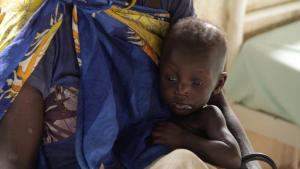With threat of severe food insecurity, WHO supports worst cases of malnutrition in children in Pibor Administrative Area of South Sudan
Juba - A visibly anxious and exhausted 25-year-old Kanyet Modi from Gumuruk payam a few kilometres from Pibor, walks into Pibor primary health care center stabilization centre in the morning hours. He appears to be losing hope holding her seven-month son Nyaprilem Baal who has fever, diarrhea and vomiting. Nyaprilem is malnourished.
Urgent provision of care was the fine line between life and potential death after he was screened and found to have severe acute malnutrition with medical complication at the outpatient therapeutic programme.
“I brought my son to the health care center because he lost appetite and extremely lost weight,” said Kanyet.
“I was going to lose my son if he was not brought to the health facility for treatment”. Nyaprilem was having fever, diarrhea and vomiting with no improvement. He was weak, and I was worried about him.”
Severe acute malnutrition is the most extreme and visible form of undernutrition. It requires urgent treatment to survive. Malnutrition can make a child more susceptible to infection. But infections can also contribute to malnutrition.
Pibor county was highly affected with floods that has resulted into displacement and destruction of the livelihood which led to food insecurity and increase in acute malnutrition cases among children.
Malnutrition on the rise
The Greater Pibor Administrative Area has been experiencing food insecurity with over 111 000 people projected to face emergency during the period December 2020 to March 2021 and high-level acute malnutrition. Since 2020 heavy floods caused massive population displacement and loss of livelihood, which limited access to food, health, clean water, protection and security to thousands of people.
“The effects of high-intensity rainfall that led to massive floods and food insecurity in the flood-prone areas of South Sudan has a negative impact on people’s health,” said Dr Olushayo Olu, the World Health Organization (WHO) Representative in South Sudan.
“We are working with the ministry of health and partners to provide the much-needed healthcare to the affected population and prepare more so that South Sudan does not fall further.”
Acute malnutrition continues to be a major public health concern and a top cause of death in children under five in South Sudan. Nearly 1.4 million children are anticipated to be suffering from acute malnutrition. Of the 1.4 million children, around 313 000 suffer from severe acute malnutrition, and 1.1 million moderate acute malnutrition.
Since beginning of 2021, WHO provided six SAM kits to support treatment of 300 severely malnourished children with medical complications in stabilization centres in counties classified under severe food insecurity.
In 2020, over 1 500 severely malnourished children with medical complications have received treatment with support from WHO through provision of SAM kits.. WHO also provided support in counselling of 611 mothers/caregiver on Maternal Infant and Young Child Nutrition in the facilities.
Treating severe acute malnutrition with medical complication
In the wake of the COVID-19 pandemic, WHO and its partners continue to work on improving access to treatment despite challenging conditions to deliver health and nutrition services due to flooding.
WHO trained 52 health care workers, including, medical doctors, clinical officers, nurses, nutrition assistants and officers and data clerks on inpatient management of severe acute malnutrition and stabilization centre reporting tools.
In addition, WHO prepositioned two boxes of psychosocial stimulation tools, child playing materials for physical, social and emotional stimulation of the children during recovery phase in the stabilization centres.
“Thanks to the generous contribution of the South Sudan Humanitarian Fund (SSHF), WHO is taking every opportunity to ensure that children suffering from severe acute malnutrition with medical complications are reached on time with lifesaving health care services”, said Dr Olu.
According to the December 2020 Integrated Food Security Phase Classification (IPC) analysis report Pibor is classified under severe food insecurity with the likelihood of famine and global acute malnutrition (GAM) threshold of over 30%. GAM is a measure used to gauge the severity of malnutrition in a population.
Once worried, Kanyet, now appreciates the return health after four days with her son in treatment.
Technical contact:
Dr Lucy Meseka, Email: mesekal [at] who.int (mesekal[at]who[dot]int)
Communications Officer
WHO Rwanda
Mobile: +250 795 450 856
Email: ebrahimj [at] who.int (ebrahimj[at]who[dot]int)
Communication Officer
Mobile: +211 921736375
Email: atema [at] who.int (atema[at]who[dot]int)
WHO Regional Office for Africa
Acting Regional Communications Manager
Email: ottob [at] who.int (ottob[at]who[dot]int)



